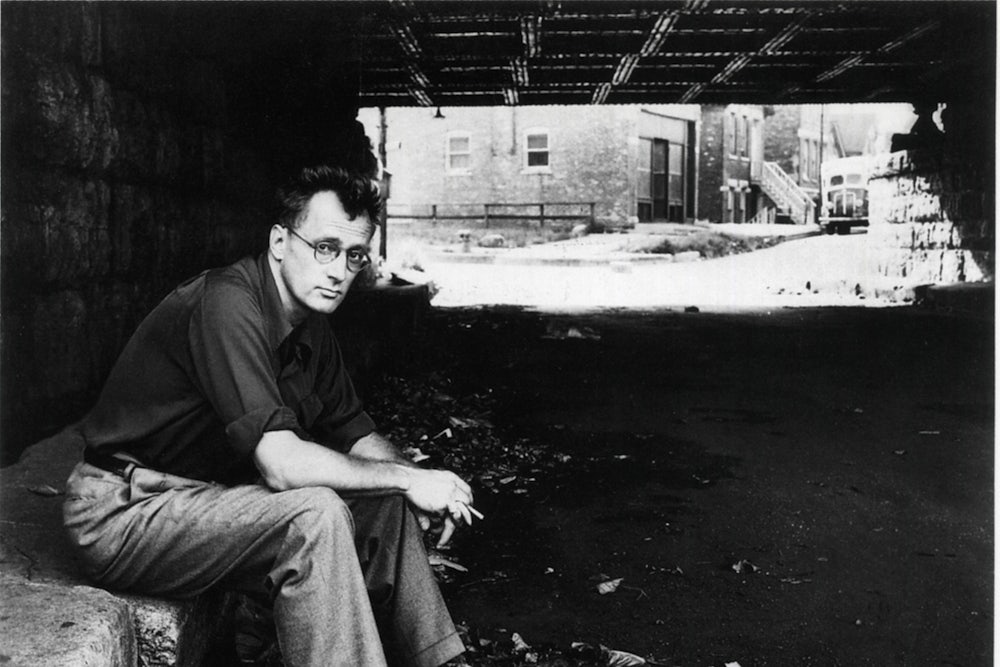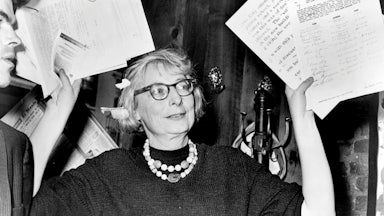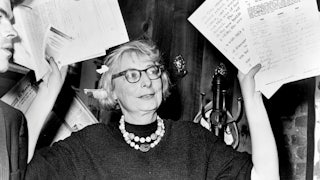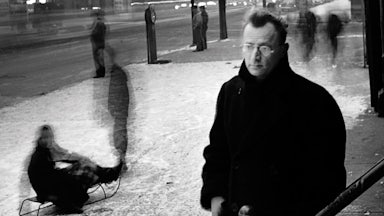When we think about the Works Progress Administration and the millions of jobs it provided, we tend to imagine heavy labor: men with pickaxes chipping away at rock for new roads, strapping masons hauling stones to construct courthouses or schools, or—the biggest dig of them all—the seven-state Tennessee Valley Authority, which built 16 hydroelectric dams. The WPA was an essential part of Franklin Roosevelt’s New Deal, and the infrastructure it provided is still used today. Yet those structures were a fringe benefit compared to its main purpose: employment.
By the time the WPA was created in 1935, it was obvious that the fiscal crisis that began on Black Tuesday in 1929 was not a mere recession: Unemployment was at 20 percent, and many Americans were losing hope of ever finding work again. The projects we now associate with the WPA are often masculinized and remembered in terms of structures alone, but much of the innovation of the New Deal was in recognizing that employment in America had fundamentally changed, moving away from purely industrial labor. In order to restart the economy fully, the country would also have to invest in knowledge workers.
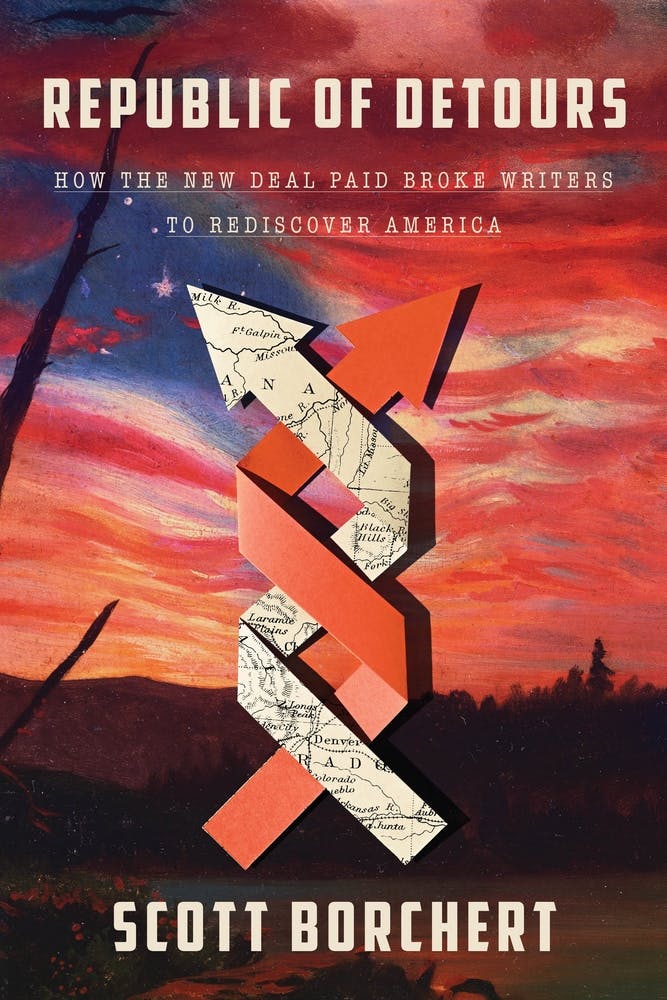
Embracing creative types in 1935 was not straightforward. With people starving on Dust Bowl farms or crowding urban soup kitchens, there was little sympathy for anyone with ink stains rather than callouses on their fingers. The new book Republic of Detours: How the New Deal Paid Broke Writers to Rediscover America by Scott Borchert explores the Federal Writers’ Project. While the FWP gave work to luminaries of the age like Richard Wright, Zora Neale Hurston, Ralph Ellison, Nelson Algren, and a young Saul Bellow, it also provided a steady paycheck to “teachers, beat reporters, clerks, lawyers, librarians, people laid off from advertising firms … white-collar workers whose jobs had disappeared.” It guaranteed a paycheck for the many people in the United States who did not work with their hands while also expanding the definition of who was a “creative.” These authors worked mainly on the FWP’s largest project: creating guide books for every state. They were definitive histories that avoided American triumphalism while also building a sense of pride and curiosity, imbuing local history with a lyrical depth that went beyond where to find a sandwich and some gas.
Borchert, through a series of biographical chapters on some of the best-known authors, engrossingly shows how the New Deal recognized art as labor and why that model should be reinvigorated today. In the past year, artists have struggled to put together Zoom theater and brand their writing on sites like Patreon, whereas in the 1930s, the FWP provided a framework for continued employment and collective endeavors for artists. With its reminder that creative labor was once seen—like a strategic reserve of fuel, weapons, or medical supplies—as worthy of federal protection, Republic of Detours mobilizes New Deal history to help us imagine what our society would be like if federal tax dollars supported a reserve army of muralists, poets, and oral historians.
When the Federal Writers’ Project began in 1935, it was headquartered in an old theater with a pipe organ in Washington, D.C. It was a good fit for its director, Henry Alsberg, who was a dramatist, author, and friend of Emma Goldman. Alsberg set the tone for the new agency, which worked alongside other New Deal cultural programs, such as the Federal Art Project and the Federal Theater Project. He was gay (in as open a way as the times would allow), left wing, and a talented raconteur with a Harvard degree but unconventional grooming standards. Under Alsberg, the agency would eventually open offices in every state, spending $6,288,000 over eight years.
Like their boss, the employees were not exactly company men (although they were, for the most part, white men). Borchert emphasizes the ideological diversity among 1930s reformers: “trustbusters and Bryanite agrarians and classical laissez-faire Democrats and progressive Republicans and assorted socialists, mingling with the usual careerists and patronage seekers.” Eventually, Alsberg got the D.C. office upgraded, taking over the mansion of a prominent family who owned The Washington Post but had fallen on hard times and were forced to rent it to the government. The image of scruffy writers reading copies of the New Masses with their feet on the furniture delighted supporters of the New Deal and infuriated the aristocrats of the old order.
The artists employed by the FWP were writers in a very broad sense: They were hotel clerks who composed poetry between check-ins, ad men, and some who already had national profiles. One man came to the D.C. office telling FWP employees that he was a “twenty-pound poet.” Responding to their quizzical expressions, he explained that he had a 20-pound suitcase filled with poems he hoped to publish through the new department. The FWP used experience to decide which writers should be managers and which should join the rank and file. Those in need of relief were officially unemployed knowledge workers who could be supported with jobs, while more experienced writers were hired in smaller numbers as editors without having to show they were in poverty. The system tended to turn more credentialed and educated creatives into gatekeepers for semi-professionals, although some of the “bosses” came from uniquely hardscrabble backgrounds, reflecting the spirit of the times.
Vardis Fisher, the editor of the Idaho guide, was one such outsider who, despite holding a Ph.D. from the University of Chicago, was not a member of the literati. He came from a family of rural homesteaders near the Snake River and found his way to high school and university by intense autodidacticism and voracious reading. His first wife killed herself in front of him and their children when he announced he was leaving her, and his work often reflected a deep sense of melancholy. After teaching at a number of universities, he was relieved to return to Idaho in order to work for the FWP. Like many writers of the time, he was finding a uniquely Western literary style that celebrated grand open spaces without cowboy sentimentality (a trait passed on to his student Wallace Stegner). In the Idaho guide, which he wrote nearly single-handedly in a frenzy of trips around the state, he begins with an arresting first paragraph, unusual for a guidebook. “The lusty and profane extremes” of the American frontier, he wrote,
still live nebulously in the gaudy imbecilities of newsstand pulp magazines and in cheap novels.… But these villains with their Wild Bill mustaches, these apple-cheeked heroines agog with virtue, and these broad adolescent heroes who say “gosh ding it” and shoot with deadly accuracy from either hand are remote in both temper and character from the persons who built the West.
Fisher’s Idaho guide with its bold—borderline acerbic—style was in fact the first to be published, in 1937. It was rushed to press far from the D.C. central office, against the wishes of Henry Alsberg, showing how, despite the New Deal’s desire for more coordinated national government, federalism still reigned supreme. Like the subsequent guides, it retained the editor’s vision, even when that meant sacrificing consistency across the series.
The second guide to appear was for Washington D.C. Writers had operated in a tempest of information-gathering from the FWP central office to produce it. The original unedited version clocked in at over one million words. When FDR received the final version—a greatly reduced but nonetheless 1,141-page volume—he quipped that it should come with a steamer trunk. Indeed, the scope of the guides—from travel advice to history to cultural encyclopedia—embraced a maximalism that seemed to wish away the scarcity of the Depression. The depth of historical research and the meticulous mapping of each state appeared in themselves to be an argument for bigger government.
The FWP was also a state-led response to a more grassroots phenomenon: The 1930s was a time of burgeoning output from magazines, even when the writers did not get paid. Nelson Algren, who worked in the Chicago FWP office, spent the early 1930s writing articles for “mushroom mags”: new magazines that sprang up overnight to address the political economic issues on all Americans’ minds, often in a more radical register than established newspapers. Algren brought social realist content to the FWP: Immediately before joining, he had been riding the rails with homeless men in boxcars and sending dispatches that provided a literary version of Dorothea Lange’s photographs.
Richard Wright was also a member of the Chicago office (and later worked in the FWP New York office with older luminaries of the Harlem Renaissance, such as Claude McKay). Along with Algren and others, his time at the FWP was marked by a honing of his literary craft toward a new kind of modernism that was unabashedly political. In the only volume of the project that was dedicated to purely creative work, American Stuff, he authored a sociological essay called “The Ethics of Living Jim Crow.” It detailed the racial terrorism of his boyhood in the Deep South, including the deeply codified and ritualized interactions of white domination. The chapter, a masterpiece of form and a prelude to Black Boy, was a gripping reminder of how the FWP presented a kind of artistic patronage scheme very different from other programs.
Yet it would also provoke a renewed assault on New Deal ventures by “red hunting” reactionaries. Conservatives, including members of FDR’s own party, had WPA projects in their sights from the beginning. The Mississippi Democrat Senator Theodore Bilbo had learned of a mixed-race gathering held by Alsberg and called it this “off-colored party of mental prostitutes,” continuing that, if this had happened in Mississippi, “those who perpetrated it would have decorated the tallest magnolia tree available.” With antagonists like that, FWP officials had to tread lightly when it came to their Southern guides, in which an accurate telling of state history could be explosive and potentially expose writers to personal danger.
While “Negro Units” existed in Northern states to research African American life and history (including by taking invaluable oral histories of former slaves), Black writers were less common below the Mason Dixon line. One notable exception was Zora Neale Hurston, who worked in her native Florida. Forced to take a lower position than her exceptional reputation as a folklorist warranted, she nevertheless embraced the project with aplomb, sending dispatches from rural portions of the state. Florida, despite growing tourism and real estate economies, was hit hard by the Depression, with the most people on relief per capita of any state. Borchert notes that Hurston was in a difficult political position in Florida: Pressure was already building on the FWP to sanitize American history and focus on “palm trees and bathing beauties.”
Hurston herself was more inclined to focus on ethnographic details of African American communities, inspired by her research with the pioneering anthropologist Franz Boas, rather than on Jim Crow and white supremacy. Hurston wrote about citrus pickers, lists of local sayings, and even about a “supernatural alligator” from her hometown of Eatonville. Indeed, her unwillingness to condemn life in the South had already earned her a feud with Richard Wright, who said that her novel Their Eyes Were Watching God “voluntarily continues … the tradition which was forced upon the Negro … the minstrel technique.” If Hurston’s “aim was to bestow a poetic dignity” on the South, Borchert writes, Wright’s “was to reveal—and sometimes sensationalize—social decay.”
Despite criticism of the FWP as a hotbed of Communists, Hurston’s prominent role in the Florida project shows a wide ideological spectrum. She would go on to criticize the FWP and all of the New Deal, in the 1940s, as her political sympathies shifted rightward. The ferocity of the arguments held within FWP offices and the feuds between writers was used by opponents to portray an agency succumbing to chaos, but it also showed a healthy amount of debate and introspection within an institution that could have been little more than a government mouthpiece.
The dam finally broke for the Federal Writers’ Project when a Democratic Congressman from Texas, Martin Dies Jr.—who had formerly supported FDR—went after artists in a red-baiting role he would reprise in the postwar era. Starting in 1938, he began subpoenaing Alsberg and his staff, finding many Communist Party memberships and workplace debates about Trotsky versus Stalin. While the project continued until 1943, Dies was instrumental in hobbling it permanently. Other programs would follow, most notably the National Endowment for the Arts (begun in 1965), but they would take a fundamentally different approach: Rather than direct employment, they provided grants, which did not secure the same level of stability for writers and artists.
Borchert makes clear that the FWP represented a visionary part of the New Deal. It never served as a propaganda unit for FDR, despite giving him some good press, avoiding the tendency of strong governments to conscript artists merely as boosters. Instead, the FWP was part of a broader push to communicate between citizens and the government in order to build knowledge and restore trust. The didactic nature of the state guides sets them apart from later tourism books, such as Fodors and Lonely Planet, which communicate local history and culture in digestible and forgettable boxes of text. Like FDR’s Fireside Chats, FWP guides were meant to reassure Americans that they were from a resilient country that had gone through previous hardships, while giving them a lesson on politics, economics, and history. Although the message could be a bit paternalistic, it focused on diversion and amusement in troubling times. Their aim was to spur low-cost and local tourism when happiness was in short supply.
Today, we may be prone to think about federally funded infrastructure in the terms provided by Donald Trump’s Infrastructure Week: a pageant of backhoes and monster dump trucks with a boondoggle of lucrative contracts for private companies. No question, the U.S. needs new roads, rails, and dams, but it also needs public libraries, murals, community theater, and archivists to document local history. Infrastructure must be redefined to encompass what makes a healthy community and not just how many sticks of rebar a bridge needs to stand up for the next 60 years.
A new Federal Writers’ Project could employ creatives and harness their energy to build civic dialogue. Arts infrastructure could be provided by staging skits about carbon capture at local libraries; making TikTok videos about mRNA vaccine innovations; disseminating Instagram poems about local landmarks; or bringing together retirees to learn how to write autobiographies from an unemployed journalist.
The FWP guides are a blueprint for two kinds of nationalism. One is a locally based experience of history beyond state fairs and historic home tours. The trips are inexpensive and do not involve long airplane journeys (some could even be done on a bicycle), producing a more democratic form of tourism. They also celebrate America without expunging the many tragedies of American history. The second kind is a belief that government can solve problems: that federal jobs can forge a unique sense of national purpose and can produce useful products. Not just solar panels and commuter rail but creative outputs that recognize a society that engages in many different kinds of labor.
